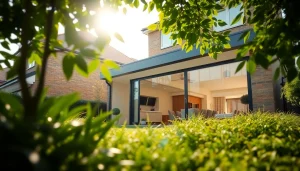Understanding Landscaping Company Pricing: A Comprehensive Guide to Your Landscape Investment
Introduction to Landscaping Company Pricing
Understanding the pricing structures of landscaping companies is essential for homeowners looking to enhance the aesthetic appeal of their properties. Landscaping isn’t just a service; it’s an investment in your home’s value, outdoor enjoyment, and environmental sustainability. Many factors contribute to landscaping company pricing, including the scope of work, materials used, and regional market conditions. This guide delves deeply into various aspects of landscaping pricing, empowering you to make informed decisions that align with your budget and preferences.
What Influences Landscaping Company Pricing?
Average Costs Across Different Landscaping Services
The average cost of landscaping services can vary dramatically based on the type of service you require. For instance, basic lawn maintenance can range from $50 to $200 per visit, while comprehensive landscape design services can cost between $1,500 and $5,000 or more, depending on complexity and size. Adding hardscaping elements, like patios and walkways, typically incurs higher costs, often reaching $15 to $50 per square foot. Understanding these averages will help you benchmark the quotes you receive against industry standards.
Importance of Budgeting for Landscaping Projects
Budgeting for landscaping is crucial for ensuring that your project doesn’t turn into a financial burden. A well-prepared budget allows for flexibility to handle unexpected costs and ensures that you can achieve the desired results without overspending. It’s advisable to allocate around 10-20% of your overall budget as a buffer for unforeseen expenses, such as grading issues or pest infestations that might arise during the project. Moreover, being well-informed about potential costs will help avoid unanticipated financial strain.
Factors Affecting Landscaping Prices
Size and Type of Landscape Project
The size and type of landscaping project are pivotal in determining the overall costs. Larger properties require more extensive work, which typically leads to higher costs. For example, the installation of a simple garden may be relatively inexpensive, while a full-scale landscape redesign could involve substantial costs. Projects that involve intricate features, like water fountains or retaining walls, are inherently more complex and expensive due to the precision required and the materials needed.
Material Choices and Their Cost Implications
Materials selected for your landscaping significantly influence the pricing. Natural stone, for example, can substantially increase project cost compared to budget-friendly options like concrete. While high-quality materials enhance durability and aesthetics, it’s essential to balance these choices with your budget constraints. Utilizing local materials can also cut costs, and selecting low-maintenance options can lead to savings over time.
Labor Costs and Expertise in Landscaping
Labor costs vary not only by region but also by the expertise of the landscaping professionals hired. Skilled landscapers and horticulturists may charge a premium for their services, yet their high level of workmanship can ensure longevity and quality in your landscaping project. On the other hand, hiring less experienced labor might initially appear cost-effective, but poor execution can lead to additional costs down the road when needing repairs or adjustments.
Breaking Down Landscaping Company Pricing Structures
Hourly Rates vs. Project Quotes
When hiring a landscaping company, understanding whether to expect hourly rates or fixed project quotes is essential. Hourly rates can range between $50 and $150, depending on the service’s complexity and the company’s reputation. Conversely, project quotes typically encompass a detailed breakdown of costs, materials, and labor, which can simplify budgeting and expectations. While hourly pricing might seem more transparent, project quotes can often be more beneficial for larger, comprehensive projects.
Potential Hidden Costs to Consider
Many homeowners overlook hidden costs that can arise during a landscaping project. These may include site preparation, cleanup, disposal of waste, and permits that some municipalities may require. It is important to ask for a complete breakdown of the quote to ensure these aspects are included or to budget for extra expenses that may emerge later. Transparency between the homeowner and the landscaping company can mitigate surprises and promote satisfaction with the final results.
Seasonal Pricing Trends in Landscaping Services
Landscaping costs can fluctuate based on seasonal trends. For instance, many companies offer discounts during off-peak seasons such as winter, making it an excellent time for planning and executing projects. Conversely, demand typically peaks during spring and summer, leading to potentially higher prices as companies adjust to increased demand. Understanding these trends can assist you in timing your landscaping projects for optimal savings.
Comparing Landscaping Pricing Among Competitors
How to Gather and Compare Quotes from Landscaping Companies
When comparing quotes, it’s essential to gather proposals from multiple landscaping companies to get a well-rounded perspective on pricing. Obtain at least three quotes and ensure they include similar scopes of work, material options, and timelines. This not only gives you a clearer picture of the marketplace but also allows for negotiating prices and services based on competitive offers. Don’t hesitate to ask for itemized quotes; they can reveal which elements are inflating costs.
Evaluating the Value Against Pricing
Cost should not be the only deciding factor. Assessing the value that each landscaping company provides is equally important. Consider their past projects, customer testimonials, and warranty offers. It’s often worth paying a little extra for a company with a solid reputation and a track record of quality work, as this can prevent potential pitfalls related to poor craftsmanship or inadequate service.
Case Studies: Pricing Examples from Different Companies
Looking at case studies can further illuminate how pricing structures play out in real-life scenarios. For example, one regional landscaping company may charge $3,000 for a comprehensive backyard design that includes a patio, garden beds, and lighting, while a national chain might provide a similar service for $2,500, but with a more rigid approach to design and implementation. Understanding these dynamics will enable you to make strategic choices relevant to your specific landscaping needs.
Best Practices for Managing Your Landscaping Budget
Setting Realistic Expectations for Your Project
Setting realistic expectations is a cornerstone of effective budgeting. Consider what you want but align those desires with your budget and timeframe. Developing a clear scope of work with your landscaping company will help ensure that everyone is on the same page, reducing the likelihood of misunderstandings that can lead to unexpected costs or delays.
Tips for Saving Costs without Sacrificing Quality
There are several strategies to save costs on landscaping without compromising quality. Opting for DIY elements, such as planting and minor landscaping tasks, can significantly decrease labor costs. Additionally, purchasing materials in bulk or selecting locally sourced options can provide savings without sacrificing the overall aesthetic. Scheduling work during off-peak seasons can also lead to substantial savings, as landscaping companies often reduce rates during quieter months.
When to Invest More for Lasting Results
In some cases, investing more upfront in quality materials or expert services can save money in the long run. These investments often result in lower maintenance costs and greater durability. For example, choosing premium native plants that are well-suited to your local climate can enhance your landscape’s resilience and reduce the need for water or chemical treatments, ultimately lowering long-term costs. Always weigh the immediate savings against the potential for future expenses when making choices about landscaping materials and services.



